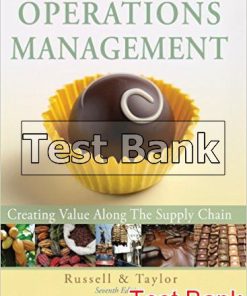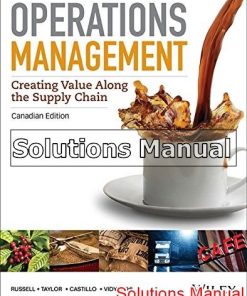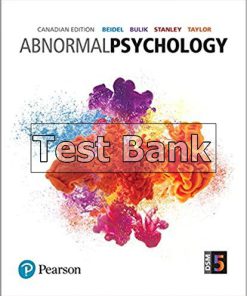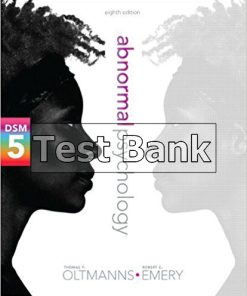Operations Management Creating Value Along Canadian 1st Edition Russel Test Bank
$26.50$50.00 (-47%)
Operations Management Creating Value Along Canadian 1st Edition Russel Test Bank.
You may also like
Operations Management Creating Value Along Canadian 1st Edition Russel Test Bank

Product details:
- ISBN-10 : 1119588723
- ISBN-13 : 978-1119588726
- Author: Roberta S. Russell, Bernard W. Taylor
Operations Management: Creating Value Along the Supply Chain, 2nd Canadian Edition is designed to teach students how to create value and competitive advantage along the supply chain in a rapidly changing global environment. Beyond providing a solid foundation, this course covers increasingly important OM topics including sustainability, corporate social responsibility, global trade policies, securing the supply chain, and risk and resilience. Most importantly, Operations Management, Second Canadian Edition makes the quantitative topics easy for students to understand and the mathematical applications less intimidating. Appropriate for all business students, this course takes a balanced approach to the foundational understanding of both qualitative and quantitative operations management processes.
Table contents:
- Part I: Operations Management
- Chapter 1: Introduction to Operations and Supply Chain Management
- 1.1 The Operations Function
- 1.2 The Evolution of Operations and Supply Chain Management
- 1.3 Globalization
- 1.4 Productivity and Competitiveness
- 1.5 Strategy and Operations
- 1.6 Organization of This Text
- 1.7 Learning Objectives of This Course
- Summary of Learning Objectives
- Summary of Key Terms
- Questions
- Problems
- S1: Supplement Operational Decision-Making Tools: Decision Analysis
- S1.1 Decision Analysis with and without Probabilities
- Summary of Learning Objectives
- Summary of Key Formulas
- Summary of Key Terms
- Solved Problems
- Problems
- Chapter 2: Quality Management
- 2.1 What Is Quality?
- 2.2 Quality Management System
- 2.3 Quality Tools
- 2.4 The Role of Employees in Quality Improvement
- 2.5 Six Sigma
- 2.6 The Cost of Quality
- 2.7 The Effect of Quality Management on Productivity
- Summary of Learning Objectives
- Summary of Key Formulas
- Summary of Key Terms
- Solved Problems
- Questions
- Problems
- Chapter 3: Statistical Process Control
- 3.1 The Basics of Statistical Process Control
- 3.2 Control Charts
- 3.3 Control Charts for Attributes
- 3.4 Control Charts for Variables
- 3.5 Control Chart Patterns
- 3.6 Process Capability
- Summary of Learning Objectives
- Summary of Key Formulas
- Summary of Key Terms
- Solved Problems
- Questions
- Problems
- S3: Supplement Operational Decision-Making Tools: Acceptance Sampling
- S3.1 Single-Sample Attribute Plan
- S3.2 The Operating Characteristic Curve
- S3.3 Average Outgoing Quality
- S3.4 Double- and Multiple-Sampling Plans
- Summary of Learning Objectives
- Summary of Key Terms
- Solved Problem
- Questions
- Problems
- Chapter 4: Product Design
- 4.1 The Design Process
- 4.2 Technology in Design
- 4.3 Design Quality Reviews
- 4.4 Design for the Environment
- 4.5 Quality Function Deployment
- Summary of Learning Objectives
- Summary of Key Terms
- Summary of Key Formulas
- Solved Problems
- Questions
- Problems
- Chapter 5: Service Design
- 5.1 The Service Economy
- 5.2 Characteristics of Services
- 5.3 The Service Design Process
- 5.4 Tools for Service Design
- 5.5 Waiting Line Analysis for Service Improvement
- Summary of Learning Objectives
- Summary of Key Terms
- Summary of Key Formulas
- Solved Problems
- Questions
- Problems
- Chapter 6: Processes and Technology
- 6.1 Process Planning
- 6.2 Process Analysis
- 6.3 Process Innovation
- 6.4 Technology Decisions
- Summary of Learning Objectives
- Summary of Key Terms
- Summary of Key Formulas
- Solved Problems
- Questions
- Problems
- Chapter 7: Capacity and Facilities Design
- 7.1 Capacity Planning
- 7.2 Facilities
- 7.3 Basic Layouts
- 7.4 Designing Process Layouts
- 7.5 Designing Service Layouts
- 7.6 Designing Product Layouts
- 7.7 Hybrid Layouts
- Summary of Learning Objectives
- Summary of Key Formulas
- Summary of Key Terms
- Solved Problems
- Questions
- Problems
- S7: Supplement Operational Decision-Making Tools: Facility Location Models
- S7.1 Types of Facilities
- S7.2 Site Selection: Where to Locate
- S7.3 Site Selection: Factors to Consider
- S7.4 Location Analysis Techniques
- Summary of Learning Objectives
- Summary of Key Formulas
- Summary of Key Terms
- Solved Problem
- Questions
- Problems
- Chapter 8: Human Resources
- 8.1 Human Resources and Quality Management
- 8.2 The Changing Nature of Human Resources Management
- 8.3 Contemporary Trends in Human Resources Management
- 8.4 Employee Compensation
- 8.5 Managing Diversity in the Workplace
- 8.6 Job Design
- 8.7 Job Analysis
- 8.8 Learning Curves
- Summary of Learning Objectives
- Summary of Key Formulas
- Summary of Key Terms
- Solved Problems
- Questions
- Problems
- S8: Supplement Operational Decision-Making Tools: Work Measurement
- S8.1 Time Studies
- S8.2 Work Sampling
- Summary of Learning Objectives
- Summary of Key Formulas
- Summary of Key Terms
- Solved Problems
- Questions
- Problems
- Chapter 9: Project Management
- 9.1 Project Planning
- 9.2 Project Scheduling
- 9.3 Project Control
- 9.4 CPM/PERT
- 9.5 Probabilistic Activity Times
- 9.6 CPM/PERT Analysis with OM Tools
- 9.7 Project Crashing and Time–Cost Tradeoff
- 9.8 Microsoft Project
- 9.9 Global and Diversity Issues in Project Management
- Summary of Learning Objectives
- Summary of Key Formulas
- Summary of Key Terms
- Solved Problem
- Questions
- Problems
- Part II: Supply Chain Management
- Chapter 10: Supply Chain Management: Strategy and Design
- 10.1 Supply Chains
- 10.2 The Management of Supply Chains
- 10.3 “Green” Supply Chains
- 10.4 Information Technology: A Supply Chain Enabler
- 10.5 Supply Chain Integration
- 10.6 Measuring Supply Chain Performance
- Summary of Learning Objectives
- Summary of Key Terms
- Summary of Key Formulas
- Solved Problem
- Questions
- Problems
- Chapter 11: Global Supply Chain Procurement and Distribution
- 11.1 Procurement
- 11.2 E-Procurement
- 11.3 Distribution
- 11.4 Transportation
- 11.5 The Global Supply Chain
- Summary of Learning Objectives
- Summary of Key Terms
- Questions
- S11: Supplement Operational Decision-Making Tools: Transportation and Trans-Shipment Models
- S11.1 The Transportation Model
- S11.2 The Trans-Shipment Model
- Summary of Learning Objectives
- Summary of Key Terms
- Solved Problem
- Problems
- Chapter 12: Forecasting
- 12.1 The Strategic Role of Forecasting in Supply Chain Management
- 12.2 Forecasting Demand
- 12.3 Time Series Methods
- 12.4 Forecast Accuracy
- 12.5 Regression Methods
- Summary of Learning Objectives
- Summary of Key Formulas
- Summary of Key Terms
- Solved Problems
- Questions
- Problems
- Chapter 13: Inventory Management
- 13.1 The Role of Inventory in Supply Chain Management
- 13.2 The Key Elements of Inventory Management
- 13.3 Inventory Control Systems
- 13.4 Economic Order Quantity Models
- 13.5 Quantity Discounts
- 13.6 Reorder Point
- 13.7 Order Quantity for a Periodic Inventory System
- 13.8 Order Quantity for the Single-Period Inventory Model
- Summary of Learning Objectives
- Summary of Key Formulas
- Summary of Key Terms
- Solved Problems
- Questions
- Problems
- S13: Supplement Operational Decision-Making Tools: Simulation
- S13.1 Monte Carlo Simulation
- S13.2 Areas of Simulation Application
- Summary of Learning Objectives
- Summary of Key Terms
- Solved Problem
- Questions
- Problems
- Chapter 14: Sales and Operations Planning
- 14.1 The Sales and Operations Planning Process
- 14.2 The Hierarchical Nature of Planning
- 14.3 Strategies for Managing Capacity
- 14.4 Proactive Strategies for Managing Demand
- 14.5 Quantitative Techniques for Aggregate Planning
- 14.6 Aggregate Planning for Services
- Summary of Learning Objectives
- Summary of Key Terms
- Solved Problems
- Questions
- Problems
- S14: Supplement Operational Decision-Making Tools: Linear Programming
- S14.1 Model Formulation
- S14.2 Graphical Solution Method
- S14.3 Linear Programming Model Solution
- S14.4 Solving Linear Programming Problems with Excel
- S14.5 Sensitivity Analysis
- Summary of Learning Objectives
- Summary of Key Terms
- Solved Problem
- Questions
- Problems
- Chapter 15: Resource Planning
- 15.1 Material Requirements Planning (MRP)
- 15.2 Capacity Requirements Planning (CRP)
- 15.3 Enterprise Resource Planning (ERP)
- 15.4 ERP and Related Software: Connectivity and Integration
- Summary of Learning Objectives
- Summary of Key Terms
- Solved Problems
- Questions
- Problems
- Chapter 16: Lean Systems
- 16.1 The Basic Elements of Lean Production
- 16.2 Implementing Lean Production
- 16.3 Other Applications of Lean Systems
- Summary of Learning Objectives
- Summary of Key Formulas
- Summary of Key Terms
- Questions
- Problems
- Chapter 17: Scheduling
- 17.1 Scheduling Techniques
- 17.2 Loading
- 17.3 Sequencing
- 17.4 Monitoring
- 17.5 Advanced Planning and Scheduling Systems
- 17.6 Employee Scheduling
- Summary of Learning Objectives
- Summary of Key Formulas
- Summary of Key Terms
- Solved Problems
- Questions
- Problems
- Solutions to Selected Problems
- Index
People also search:
operations management creating value along the supply chain
operations management creating value
using operations to create value
|
9 step business model
|












